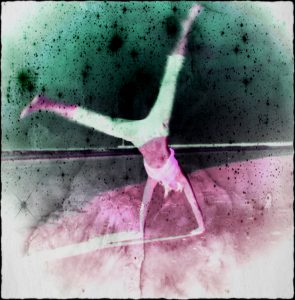
Preconceptions are so hard to dispel, especially when so many people are still out there perpetuating them. The most common, easily Googlable preconception about the flash narrative is that it needs to end in a twist. This might have been true for about 5 minutes in the 90s, but we quickly moved on. The literary flash narrative does not rely on a twist ending.
The literary flash narrative ends like a professional platform diver enters the water: perfectly, maybe subtly, assuredly with a gasp from the audience. There are consequences for the diver for under- or overshooting the entry: point reductions, pain, a broken back. For the flash writer, the consequences are less physical but equally disappointing.
As you read the example narratives from the SmokeLong archive, take out your own works in progress and give special attention to endings. For other “Five from the Archive” topics, simply CLICK HERE.
________________________

“Hatched” by Nicole Rivas
This story is one of my favorite SmokeLong stories. It’s also in Flash Fiction America, and you can hear Nicole read it during the SmokeLong Flash Fiction America reading HERE. “Hatched” is about a date gone horribly wrong. The rhythm of the final paragraph manages to bring the narrative to a halt while also moving on, out of the frame. Rivas does this cinematically, stretching the point of view of the narrator away from her date, leaving the date to pick through her possessions: or “what little remained of me.”
Writing Task: Look at one of your own works in progress. How can you end your story with a character leaving a precarious moment, stretching their point of view away from the situation, leaving all the questions open?

“Sky Like Concrete” by Mike Riess
What a miraculous thing Riess does at the end of this narrative about a complicated father/son relationship. Shifting point of view is a risky move, but Riess pulls it off masterfully. Similarly to Rivas’s ending, the ending of “Sky Like Concrete” is cinematic. You can imagine the camera rising from the accident, changing its point of view to the observer’s. Riess also uses repetition to urge the reader toward the ending, which manages to indicate a change in the father’s understanding of himself. It’s brilliant.
Writing Task: Look at one of your own works in progress. How does your last paragraph urge your reader to the coda, to that last chord, to that last moment of the narrative? Would repetitive phrases, like those in the last few lines of “Sky Like Concrete” help your narrative build more gracefully toward this moment? Is it–in the end–satisfying?

“Satellite” by Elaine Edwards
“Satellite” is about Helen, who’s going to the moon, but it’s also about the narrator’s relationship to Helen. For most of the narrative, the narrator tells you what Helen thinks, but the ending shifts toward the narrator. The language is lush and lyrical and full of such honesty that by the time we get to the last couple of phrases we finally realize that this is all about the narrator’s fear of losing Helen.
Writing Task: Draft a narrative in which a narrator tells us about another character, so much so that it feels like a third-person narrative. In the final paragraph allow the narrator to turn inward, to let us into their relationship with the subject.

“Phase Changes” by Cami Park†
This modular story from 2005, possibly meant to be a triptych influenced by the three phases of water, is a good example of how modular flash stories can offer multiple endings or codettas. Park, who remains with us only through her stories, gives us three situations–the first two with hypothetical endings, the last more final–inviting readers to make their own associations among its parts.
Writing Task: Draft a modular flash narrative in which three situations are loosely–or tightly–associated structurally by their codettas (intermediate ending).

Angela Compagnone
“Eating Stale Biscuits in the Middle of the Pacific Ocean” by Yume Kitasei
A catastrophe narrative. A tsunami has washed an entire village out into the Pacific ocean toward California. Of course we’re looking at this narrative because of its ending, but it also warrants multiple readings because of its layered, bizarre beauty. The ending asks (and then doesn’t really answer) a question: “Toe or Thumb? California?” The “character” asking the question is shark. I love this.
Writing Task: Draft a narrative in which the main character must ultimately make a difficult choice. You decide whether your ending resolves the character’s dilemma.
Other Narratives with Notable Endings from SmokeLong:
“We All Know About Margo” by Megan Pillow
“Mortality Event” by Hadiyyah Kuma
“Lobster” by Rachel Reeher
“Things I say to my son while he sleeps” by Hananah Zaheer
“Undergrowth” by Melissa Bowers
“Build-A-Bear” by Marne Litfin
“Dusk” by SJ Han
And so many more because flash endings are a thing.
____________________________
 Christopher Allen is the editor-in-chief and publisher of SmokeLong Quarterly. He is the author of the flash fiction collection Other Household Toxins, the satire Conversations with S. Teri O’Type, and over 100 works of fiction and nonfiction in good places like Booth, Split Lip Magazine, The Best Small Fictions, and Flash Fiction America (Norton). Allen has judged The Bridport Prize, The Bath Flash Fiction Award, and other flash competitions. He is a nomad.
Christopher Allen is the editor-in-chief and publisher of SmokeLong Quarterly. He is the author of the flash fiction collection Other Household Toxins, the satire Conversations with S. Teri O’Type, and over 100 works of fiction and nonfiction in good places like Booth, Split Lip Magazine, The Best Small Fictions, and Flash Fiction America (Norton). Allen has judged The Bridport Prize, The Bath Flash Fiction Award, and other flash competitions. He is a nomad.

 Try SmokeLong Fitness for two months!
Try SmokeLong Fitness for two months!